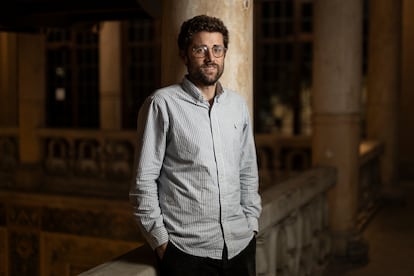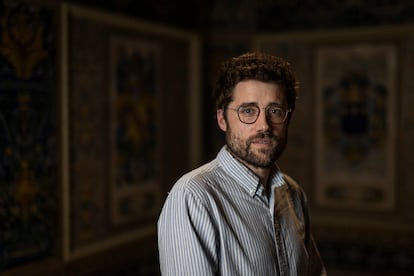Nicholas McGranahan, researcher: ‘If we don’t consider the theory of evolution when it comes to cancer, we’re bound to fail’
The University College of London scientist won the prestigious Blavatnik Award for young researchers after laying the groundwork for studying tumor development as an evolutionary process

When Darwin wrote On the Origin of Species, he wasn’t thinking about cancer, but in a way, his theory of evolution does take it into account. At the end of the day, cellular tumors, just like living beings, also fight to survive, undergo changes and pass them onto their offspring. Beginning a few years ago, many studies have been dedicated to exploring tumors as an evolutionary process, and have produced explanations for why no two tumors are alike, how they can transform to the point of metastasis, and why they generate mutations that can make them resistant to treatment. These investigations attempt to reconstruct the tumor’s past to predict their future, and in so doing, improve prognoses and design more effective treatments.
Nicholas McGranahan works at the University College of London, and this year, won the United Kingdom’s prestigious Blavatnik Award for young researchers. According to the award’s citation, he did so for having “laid a foundation for exploring tumor development as an evolutionary process,” developing tools to help understand the genetic defects that accumulate during the development of a tumor. Recently, he participated in a conference on treatment resistance organized by the Institute for Research in Biomedicine of Barcelona. During his trip to the city, he spoke with EL PAÍS about evolution and cancer, game theory and choosing between pessimism and optimistic realism.
Question. Before, one spoke about breast or lung cancer as though they were quite similar. Today, it is said that each tumor is unique and that, in addition, evolves with time. What changed?
Answer. I think we now have the technology to know not only that there is one cancer for one person, but that cancer changes over time in one person. There was a seminal paper in 1976 that introduced the concept of cancer as an evolutionary process, but I think ultimately, people already understood that might be the case. You look down a microscope at a tumor, and you see diversity, but you can’t really understand the full extent of that diversity or whether it’s just that you’re randomly looking at different things. It’s really the technology that’s transformed our understanding of the processes that generate diversity and what is causing the mutations and how resistance can emerge to treatment if you can’t remove the entire tumor. And that is an incredible challenge.
Q. What similarities and differences are there between evolution in cancer and what we usually understand to be evolution in nature?
A. The basic framework is the same. There are three key tenets of evolution by natural selection: there has to be diversity, some of that diversity has to be heritable, and there is a struggle for survival. We can see clear evidence of that in cancer. One of the main differences could be the speed of the process, which is very exaggerated. It takes place within a person’s lifetime, rather than over millions of years. That means it’s quite tricky to explore. We don’t have multiple time points before a tumor ever developed. We don’t have a fossil record.
Q. That diversity can lead to many differences between regions of the same tumor. How can you be sure about diagnosis and treatment when you are only looking at one piece of the picture with a biopsy?
A. Yes, so I think that’s a critical question. We now know that sampling bias is a serious issue, that one part won’t be representative of the whole. I think the more tumors we sequence, we can learn that there are patterns, certain alternations that are what we call truncal, and that are inherited by every subsequent cancer cell. The treatments that work tend to be the ones that are targeting the more truncal alterations. But there still could be multiple different ways for resistance to emerge, which is another key complication. If you think of how many cells there are in a tumor — it’s a billion cells. The diversity that can exist is absolutely phenomenal. It’s more or less like the “infinite forms” that Darwin described.
Q. That resistance to treatment is one of the problems of precision medicine, right? Do you think that it is living up to our expectations?
A. Unfortunately, the appearance of resistance hasn’t been the exception, but the norm. If you think, OK, I’m just going to target this one alteration, you can almost predict ahead of time that there will be resistance, you can even start to predict what that resistance will be. Many times, we can get rid of a tumor in the laboratory, but in patients with much larger tumors, you’ve got so many more potential mechanisms of resistance. I think we need to be more intelligent in how we apply these drugs,and that there is a need for other lines of research. It’s complicated, but if you’ve got a lamp with a light shining, and then you look under the lamp — that’s what you find.
One of the reasons I think that immunotherapy, which can be considered a certain kind of precision medicine, works is because you’re stimulating T cells to target multiple alterations.
Q. Your team has investigated how tumors can hide alterations so that one’s immune system doesn’t detect them, and how they can also prove resistant to immunotherapy.
A. Yes. It works better on tumors with many mutations, like that of the lungs or melanomas. Despite evolution, there are evolutionary dead ends. When there are so many mutations, they stimulate the immune system in a way that makes it capable of defeating those changes. If you look at species evolution, you do get evolutionary dead ends and there are extinctions.

Q. One of your goals is to be able to predict the evolution of tumors. Are we able to do that yet?
A. I think there are certain elements that can be predicted, but I don’t think we’re quite there yet. We need to know the rules, and we need to know the processes as to why mutations appear and are selected. But we’re much better than we were 10 years ago, and we’re continuing to advance.
Q. Treatment strategies based on evolution are being studied. Some of them are based on game theory, like the sucker’s gambit.
A. Yes, there are some attractive ideas there, but they’re more theory than practice at the moment. In the sucker’s gambit you mention, we’re trying to lead the tumor down a specific route in order for a second treatment to be more effective. Another technique would be adaptive therapy [in which the goal is not to destroy the tumor, but stabilize it and avoid it generating resistance]. There have been a few trials, but it’s a bit hard to see how successful they’ve been. We need to pay attention to combining treatments. Essentially, we need to always have evolution in mind. If we don’t consider evolution, we’re bound to fail.
Q. Tumor evolution can also lead to metastasis, generating mutations that do not appear in the original tumor, making it very hard to treat. What do evolutionary studies tell us about this?
A. Sometimes, the metastasis happens very early during the tumor’s development, before the primary tumor is clinically detectable. But in many cases, it seems to happen much later. If you remove the primary tumor before metastasis has happened, that can cure patients. When we started looking at the sequencing studies that exist, it really highlighted that there’s no clear event that we can identify, genomically at least, that defines metastasis. There are therapies that do work in the context of metastatic disease, but I very much doubt there’s going to be a single treatment that always work. It’s always more complex than that.
Q. It’s so complex that the natural thought can seem to be very pessimistic. But another way to look at it is at least we can study it and improve what hasn’t worked.
A. Yes, I definitely take the more positive view [smiles]. It’s a question I get asked quite frequently. A lot of the work we’ve done illustrates the complexity of the problem. But I think that it’s better to know how hard the problem is than to just assume it’s easy and then come up with the wrong answer. And the positive part is that we are clearly seeing certain alterations that are selected. This isn’t just random, there are clear patterns here. If we can understand the patterns, then we’re going to be far better placed to understand how to actually stop it or prevent it.
Q. Sometimes people say that the evolution of cancer has not been very successful. If it was really adapted, it would not cause the death of the person, but rather, co-exist with them.
A. Well, cancer is different from a viral infection, for example, where you have the virus and its host. Cancer is not a foreign pathogen. It doesn’t spread (except on rare occasions), which means it can’t survive forever. It’s completely selfish, to its own detriment.
Q. Why did you choose this field?
A. I studied natural sciences and was excited by evolution. Later, I realized there was an opportunity to pursue it, but with a clinical application. And cancer is an incredible system that gives us a glimpse into this evolutionary process.
Q. I suppose, then, that you agree with the Dobzhanksy saying that “nothing in biology makes sense except in the light of evolution.”
A. Definitely. We ignore evolution at our peril. To understand cancer, we need to understand its evolution.
Sign up for our weekly newsletter to get more English-language news coverage from EL PAÍS USA Edition
Tu suscripción se está usando en otro dispositivo
¿Quieres añadir otro usuario a tu suscripción?
Si continúas leyendo en este dispositivo, no se podrá leer en el otro.
FlechaTu suscripción se está usando en otro dispositivo y solo puedes acceder a EL PAÍS desde un dispositivo a la vez.
Si quieres compartir tu cuenta, cambia tu suscripción a la modalidad Premium, así podrás añadir otro usuario. Cada uno accederá con su propia cuenta de email, lo que os permitirá personalizar vuestra experiencia en EL PAÍS.
¿Tienes una suscripción de empresa? Accede aquí para contratar más cuentas.
En el caso de no saber quién está usando tu cuenta, te recomendamos cambiar tu contraseña aquí.
Si decides continuar compartiendo tu cuenta, este mensaje se mostrará en tu dispositivo y en el de la otra persona que está usando tu cuenta de forma indefinida, afectando a tu experiencia de lectura. Puedes consultar aquí los términos y condiciones de la suscripción digital.
More information
Archived In
Últimas noticias
The journal ‘Science’ criticizes Trump’s anti-renewable energy policy: ‘The US is failing to benefit from its own innovations’
Cubans hope for a miracle as dengue and chikungunya spread
The long shadow of the father figure in the films of Rob Reiner
US sanctions against jailed cartel leader ‘El Marro’ highlight Mexico’s lack of control over its prisons
Most viewed
- Christian Louboutin: ‘Young people don’t want to be like their parents. And if their parents wear sneakers, they’re going to look for something else’
- ‘El Limones’ and the growing union disguise of Mexican organized crime
- Cartels in Mexico take a leap forward with narco-drones: ‘It is criminal groups that are leading the innovation race’
- ‘We are dying’: Cuba sinks into a health crisis amid medicine shortages and misdiagnosis
- The low-cost creative revolution: How technology is making art accessible to everyone










































